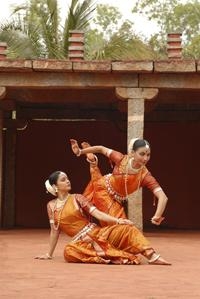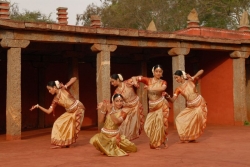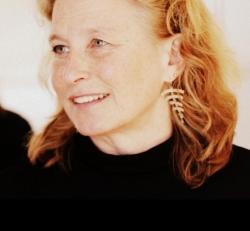
Dance On Film ~ Nrityagram: For the Love of Dance
- Library Hall
A film by Nan Melville about India's rare and beautiful Odissi dance form, and the village that is devoted to preserving it.
Nrityagram: For the Love of Dance debuted as an official selection of the Film Society of Lincoln Center and Dance Films Association, Dance on Camera Festival in New York City. The New York Times’ chief dance critic Alistair Macaulay said, “Many intelligent points are made, and much of the dance footage, not least during the closing credits, is spellbinding. I wanted the film to be twice as long.”
About the film
Film maker Nan Melville first met the Nrityagram Dance Ensemble when they were far from their home base near Bangalore, India. She was assigned by the New York Times to photograph their debut performance In New York in 1996. The rave review that followed launched them on the cultural scene.
Nan was so enchanted by the dancers, and the concept of Nrityagram – a village devoted to dance – that she jumped at Protima Bedi’s invitation to visit the school in India – and subsequently decided to make a documentary film about the Nrityagram Dance Village and Ensemble.Her mission is to capture for posterity the story of the dance village and the dancers, and how they promote and develop the Odissi dance form.
The Odissi dance form from the state of Orissa is said to have originated approximately 2000 years ago. Odissi was originally a temple dance meant to entertain the deity. The movements in Odissi mimic the serpentine poses and minutely detailed gestures of Hindu gods in ancient temple sculptures During the British Colonial period in India, colonial administrators discouraged all forms of Indian dance because many in the Victorian Age saw dance as immoral. An act banning female dancers from performing in temples was passed and dance was banished from social life. The patronage of the princes for dance waned and Indian classical dance was not appreciated or taught for decades. Odissi and other Indian dance forms went into decline, nearly disappearing.
In the 1930s, the Indian nationalist movement worked to gain independence from British rule and to revive all forms of Indian art. By the time India achieved independence in 1947, dance was firmly established as an art form worthy of practice. A number of individuals were instrumental in lifting Indian classical dance out of obscurity, and whose influences are still felt to this day. One such individual was Protima Gauri Bedi, a socialite who devoted herself to learning the Odissi dance form after seeing the guru Kelucharan Mohapatra dance in 1975.
In 1988, with the help of many supporters, Protima built Nrityagram – a dance village that is home to an all-female dance ensemble of the same name. Company members live together and study their art with master gurus in the gurukul (house of the guru, or teacher). Odissi is a demanding art. Training for the dancers takes place eight hours a day, six days a week. In this holistic community, in addition to intensive dance training, the dancers learn literature, mythology, poetry, Sanskrit, music, aesthetics, history of dance, philosophy, spiritual thought, and dance theory. They also participate in workshops in martial arts, yoga, mime, meditation, sculpture, etc. The end result is a dance company whose synchronicity and skill in Odissi is unparalleled, and whose dancing reveals none of this effort.
Run time: 30 min.
The Dance on Film series is presented by the Bud Werner Memorial Library, Perry-Mansfield and Steamboat Dance Theatre.
The free screening includes an introduction by dance history professor and Perry-Mansfield Executive Director Joan Lazarus.
About the film's commentator
Joan Lazarus served as Executive Director of Oakland Ballet, General Manger of Cowell Theater at Fort Mason Center, and Executive Director of WestWave Dance, an annual festival of new choreography presented in San Francisco. Joan has performed with or in the works of Alonzo King, Cliff Keuter, Ellen Bromberg, Victoria Morgan, Krissy Keefer, Frank Shawl, Bill DeYoung, Toni Pimble, Richard Colton and Alan Ptashek. She taught at the University of Oregon, Mills College, San Francisco Ballet, Dance Circle of Boston, The Princeton Ballet, RoCo Dance & Fitness, and Shawl-Anderson Dance Center, and co-authored the Dance Curriculum Guide adopted by the San Francisco Unified School District. She received Bay Area National Dance Week’s Contribution to the Field of Dance Award in 2006, and in 2012 she received an Isadora Duncan Dance Award for Sustained Achievement. Lazarus was named 2011 Dance MVP by the San Francisco Chronicle. Joan joined the staff at Perry-Mansfield in June 2012.
About Dance On Film
This 2013 Dance On Film series is presented by Bud Werner Memorial Library, Perry-Mansfield and Steamboat Dance Theatre. Perry-Mansfield celebrates its 100th anniversary as the oldest continuously operating arts camp in the United States this year. Steamboat Dance Theatre is a community dance organization presenting its 42nd annual concert March 20-22, 2014, in addition to year-round dance scholarships and education programs in Yampa Valley schools and throughout the community. This collaborative and educational dance film series features free screenings of the hottest new dance documentaries along with the finest classic dance films from a variety of genres filmed throughout the ages.
All images courtesy Nan Melville
















